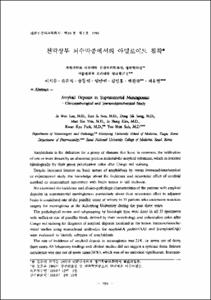KUMEL Repository
1. Journal Papers (연구논문)
1. School of Medicine (의과대학)
Dept. of Neurosurgery (신경외과학)
천막상부 뇌수막종에서의 아밀로이드 침착
- Keimyung Author(s)
- Son, Eun Ik; Yim, Man Bin; Kim, In Hong; Park, Kwan Kyu
- Journal Title
- 대한신경외과학회지
- Issued Date
- 1995
- Volume
- 24
- Issue
- 7
- Abstract
- Amyloidosis is the definition for a group of diseases that have, in common, the infiltration of one or more tissues by an abnormal protein material-the amyloid substance. which is detected histologically by their green polarization color after Congo red staining.
Despite increased interest on basic nature of amyloidosis by recent immunohistochemical or experimental study. the knowledge about the incidence and neurotoxic effect of cerebral amyloid or concomitant occurrence with brain tumor is still inchoate.
We examined the incidence and clinico-pathologic characteristics of the patients with amyloid deposits in supratentorial meningiomas. particularly about their neurotoxic effect to adjacent brain is considered one of the possible cause of seizure in 33 patients who underwent resection surgery for meningioma at the Keimyung University during the past three years.
The pathological review and subgrouping by histologic type were done in all 33 specimens with sufficient size of paraffin block, defined by their morphology and polarization color after Congo red staining for diagnosis of amyloid deposits localized in the tumor. Immunohistochemical studies using monoclonal antibodies for amyloid-A protein(AA) and β-amyloid(Aβ) were evaluated to identify subtypes of amyloidosis.
The rate of incidence of amyloid deposit in meningioma was 21%, i.e. seven out of thirty three cases. All laboratory findings and clinical studies did not suggest a systemic ferm. Seizure occurrence was one out of seven cases(14%), which was of no statistical significance. Immuno-histochemical study for AA subtype was all negative. but showed all positive for Aβ protein around the vessels. Recent reports has also demonstrated that Amyloid precusor protein(APP) and Aβ is related in Alzheimer's disease, hereditary cerebral hemorrhage with amyloidosis-Dutch type(HCHWA-D) and amyloid angiopathy.
Our research data indicates that the incidence of amyloid deposit is as high as 21 % in supratentorial meningiomas. It seems that it is one of the possible cause of seizure. Nonsystemic microdeposits of amyloid and their subtype and it's relationship to neurotoxic effect in meningiomas remain to be confirmed by immunoelectron microscopic examination or immunohistochemical methods.
본원에서 1991년에서 1993년까지 3년동안 수술을 시행한 33례의 수막종 환자를 대상으로 아밀로이드의 침착율과 경련을 중심으로 한 신경학적인 검사, Aβ 단백질에 대한 면역화학적 검사를 실시한 결과 비교적 많은 예인 7례(21%)에서 아밀로이드 침착을 보였으며 경련은 아밀로이드침착을 보인 7례 중 1례에서 볼 수 있었으며 7례 모두 Aβ단백질에 대한 항체가 혈관주위에 강하게 침착되어 있었다. 비록 신경학적인 검사상 아밀로이드의 침착이 나나타난 예에서 신경독성효과(neurotoxic effect)의 소견은 없지만, 전기생리학적 검사상 인접 뇌조직에 신경자극효과(irritative effect)의, 특히 경련을 나타낼 수 있는, 가능성은 있는 것으로 볼 수 있다.
향후 더 많은 예를 대상으로 최근의 면역전자현미경 검사와 다양한 항체를 이용한 면역조직화학적검사 방법으로 연구하여, 아밀로이드의 미세침착으로 인한 뇌혈관이상과 인접조직의 신경독성효과와 함께 subtype과의 연관성이 규명되면 삶의 질이 감안된 수막종의 수술적 가료에 도움이 될 것으로 생각된다.
- Alternative Title
- Amyloid Deposits in Supratentorial Meningiomas - Clinicopathological and Immunohistochemical Study -
- Publisher
- School of Medicine
- Citation
- 이시우 et al. (1995). 천막상부 뇌수막종에서의 아밀로이드 침착. 대한신경외과학회지, 24(7), 794–799.
- Type
- Article
- ISSN
- 1225-8245
- Appears in Collections:
- 1. School of Medicine (의과대학) > Dept. of Neurosurgery (신경외과학)
1. School of Medicine (의과대학) > Dept. of Pathology (병리학)
- 파일 목록
-
-
Download
 oak-bbb-1706.pdf
기타 데이터 / 408.82 kB / Adobe PDF
oak-bbb-1706.pdf
기타 데이터 / 408.82 kB / Adobe PDF
-
Items in Repository are protected by copyright, with all rights reserved, unless otherwise indicated.